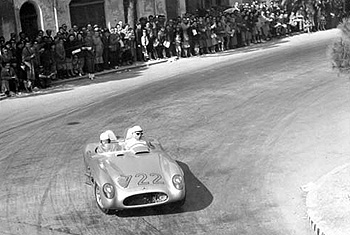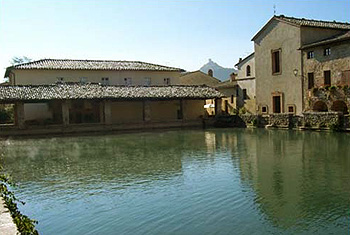Mille Miglia

The "Mille Miglia" – Italian for “Thousand Miles” - was created in 1926 at the initiative of a group of young racing car drivers who formed the Board of the Automobile Club of Brescia. Along with politicians, journalists and organizers of the time, they put in place the idea of a new event, a race reserved for long-distance vehicles. The peculiar idea of the "Mille Miglia" was to make a race that was not on an organised track, unlike most races that were in practice at the time, such as "24 hours" of Le Mans, which was introduced in 1923.
The idea was simple and brilliant: bringing the cars on the roads of Italy, so that hundreds of potential buyers could see them. The project was strongly backed by car manufacturers, who wanted to boost sales, and the fascist government that was hoping to promote a modern looking Italy. In addition, the government hoped to boost the car market in order to gain from road taxes and taxes on fuels and lubricants.
Also the citizens could take an indirect benefit from the competition: the race would become an opportunity to improve the road network involved in the event. The name of the race was disclosed on December the 2nd, 1926, and since then the name “Mille Miglia” became the symbol of Italian motor sport.
ITINERARY 7: “Mille Miglia Northbound”
km 110 / 1-2 days
This itinerary follows the route of the Mille Miglia in the stretch between Florence and Bologna, perhaps the most challenging for the drivers and striking for the beauty of the landscape. The route is 110 kms and is almost exclusively made up of winding mountain roads that allow you to cross the Apennines mountains from south to north. Leaving the city of Florence behind you, the road starts immediately to climb the hills that separate the town from the Mugello valley. From 'San Piero a Sieve' the Futa road starts; miles of twists and turns, through breathtaking landscapes, leading to the homonymous pass at 903m above sea level. From the Futa pass, driving through a landscape made of valleys and mountain meadows, you reach the Raticosa Pass at 968m above sea level. After the Raticosa pass the road begins its descent towards Bologna: the rugged mountains becoming more and more gentle until they turn into rolling hills that eventually lead into the Po Valley.
ITINERARY 8: “Mille Miglia to Galleria Ferrari”
km 160 / 2-3 days
Galleria Ferrari
This is your chance to see with your own eyes the factory that builds the most famous cars in the world. A visit to the Galleria Ferrari is not only important in terms of discovering the company's glorious history. It is also a way of exploring the key stages in the development of the automobile industry and Ferrari's contribution to it in terms of innovative technology and safety over its 55 year history.


ITINERARY 9: “Mille Miglia Southbound”
km 159 / 2-3 days
Monteriggioni
Monteriggioni is a beautiful, small town surrounded by 14 fortified towers. During the Middle Ages it offered a shelter to the people of Siena during the wars against Florence. Perfectly preserved and closed to traffic, in July the village of Monteriggioni hosts one of the most beautiful medieval festivals in Italy. The town was founded around a farm located along the Francigena route, the road used by pilgrims linking Canterbury to Rome.
Siena
A city that needs no introduction, with a unique atmosphere. The severe palaces and steep alleys of the old town have remained the same since the middle ages when Siena was an independent republic. A large part of the ancient pride is still present in the attitude of its citizens, which is expressed fully on July 2 and August 16 of each year during the famous Palio, perhaps the oldest and most authentic popular celebration in Italy. At the heart of the city is the magnificent shell-shaped Piazza del Campo, dominated by the high Torre del Mangia and considered one of the most beautiful squares in Europe for architectural harmony and balance. However, Siena also offers beautiful churches and museums in addition to its ability to surprise even the most hurried visitor with unforgettable views. The old town is a UNESCO World Heritage Site.
San Quirico d'Orcia
Located in the heart of the beautiful Val d'Orcia, San Quirico d'Orcia is a fortified city well worth a visit. A must see is the Collegiata dei Santi Quirico e Giulietta featuring the beautiful Gothic-Romanesque portals, the churches of Santa Maria di Vitaleta and Della Misericordia, the Praetorian Palace and the Palazzo Chigi. To complete the tour, the Leonini Gardens are splendid examples of Italian gardens, which were created in 1540 by Diomede Leoni.
Bagno Vignoni
Bagno Vignoni has been famous since Roman time for its thermal waters. The ancient city was given new impetus by the proximity of the Via Francigena, the medieval pilgrimage route that linked Canterbury to Rome. The central square of Bagno Vignoni is taken up by the pool, no longer used for the public but still very impressive, which reflects the surrounding stone buildings. Even Santa Caterina da Siena was immersed in these waters! The thermal baths of the town are still active and offer a wide range of treatments.